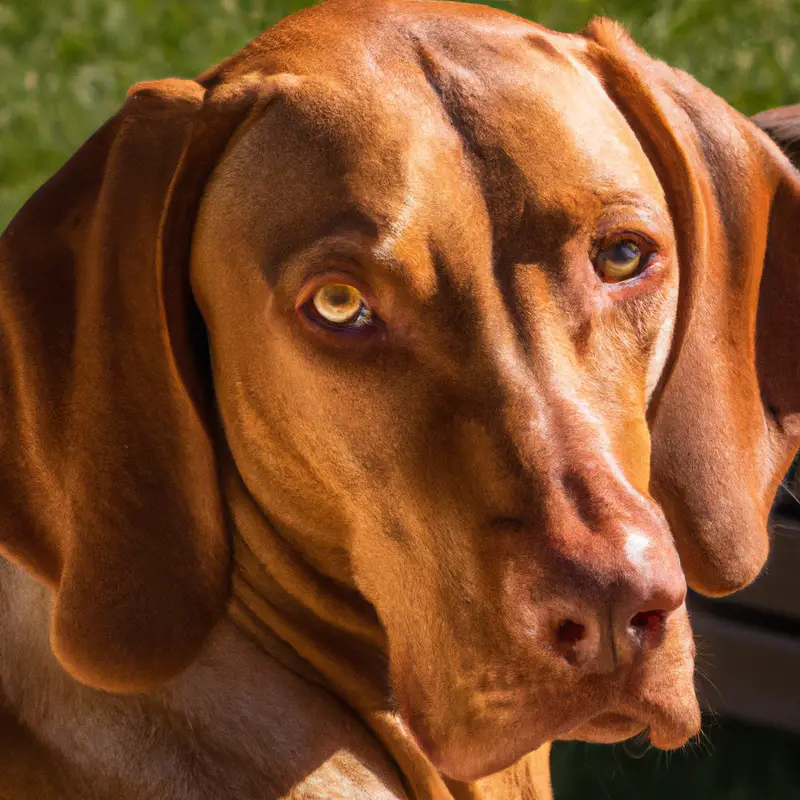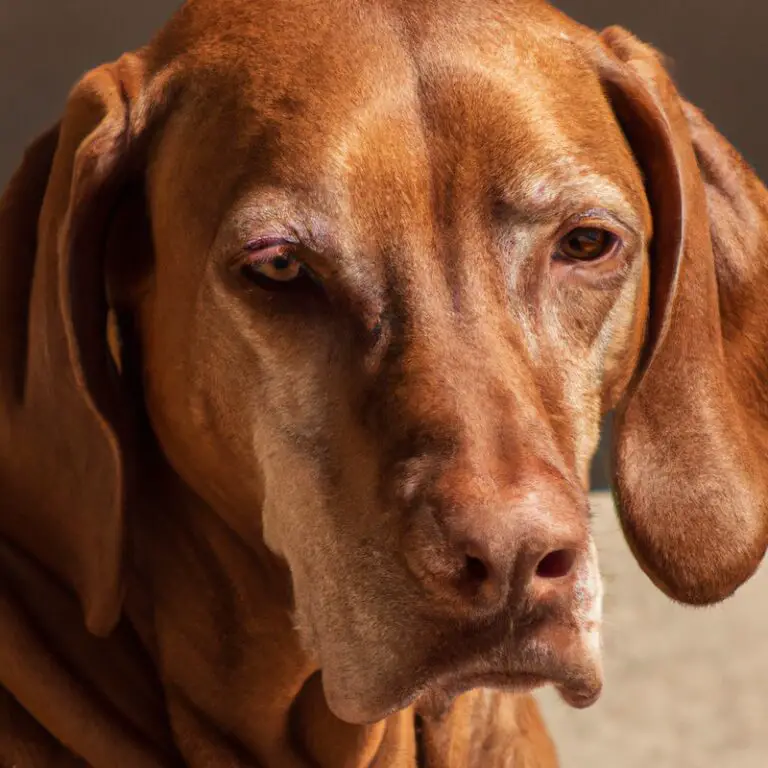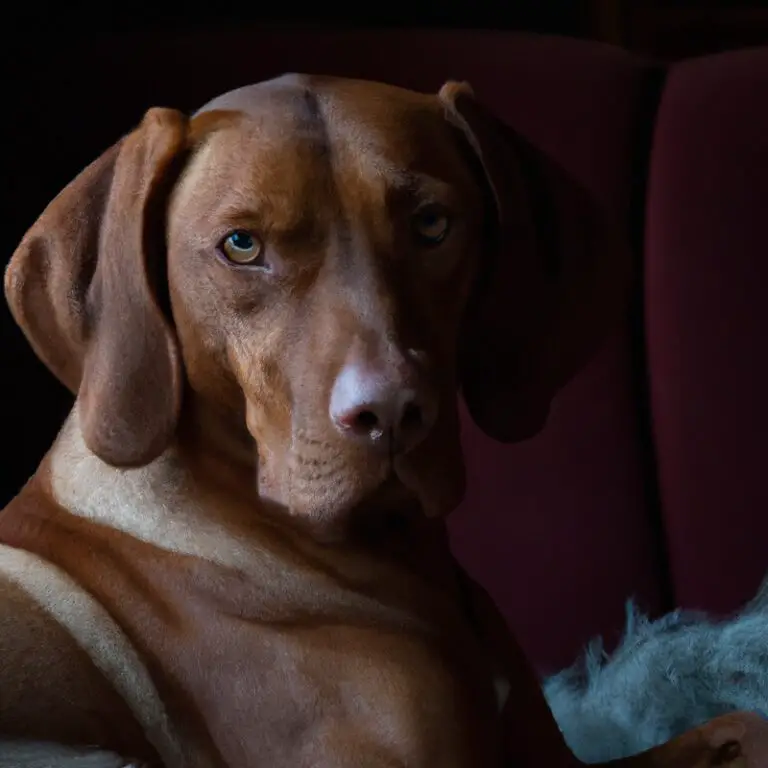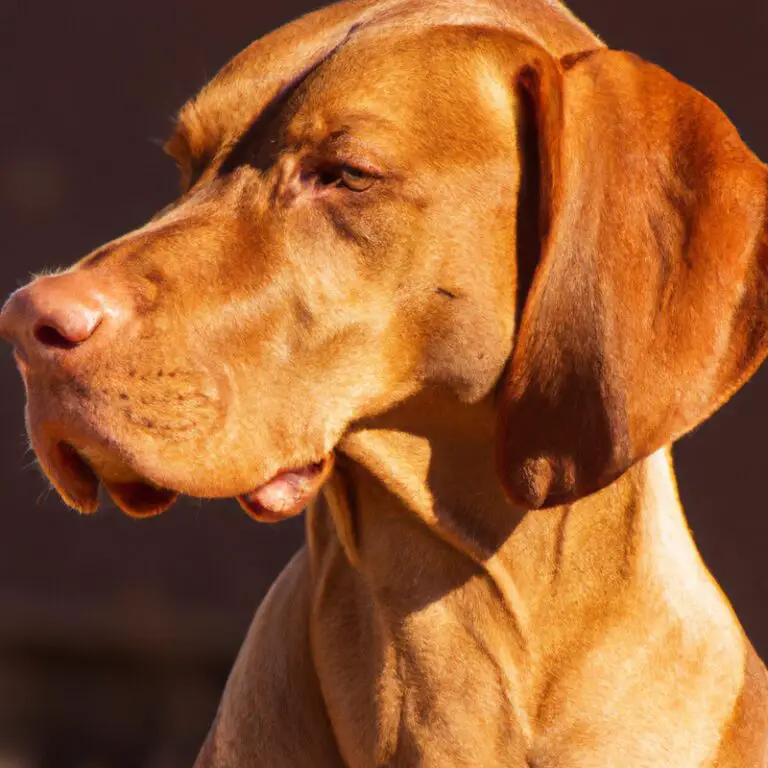What Are Some Common Vizsla Skin Conditions And How To Manage Them?
Key Takeaways:
- Vizslas are prone to common skin conditions such as allergies, dermatitis, and hot spots.
- Regular grooming, proper nutrition, and avoiding allergens can help manage Vizsla skin conditions.
- Consulting a veterinarian and following their recommendations is crucial in managing Vizsla skin conditions.
- Early detection and prompt treatment are important for improving the overall skin health of Vizslas.
Are you a proud Vizsla owner, basking in the love and energy of your furry companion?
Well, when it comes to Vizslas, there’s one thing that not all pet owners may realize: these magnificent dogs are prone to certain skin conditions.
But fret not! As an expert in Vizsla care, I’m here to guide you through the world of common skin issues, from allergies and hot spots to dry skin and dermatitis.
In this article, we’ll take a deep dive into the symptoms, causes, and effective management strategies for each condition.
So, let’s dive in and ensure your Vizsla’s skin is as healthy as their spirit!
| Skin Condition | Symptoms | Management |
| Allergies | Itching, redness, rashes, hair loss | Avoid allergens, regular grooming, medicated shampoos |
| Hot Spots | Moist and red sores, pain, itching | Antibiotics, topical creams, keeping area clean and dry |
| Mange | Severe itching, hair loss, scaly skin | Medicated dips, oral medication, regular veterinary checks |
| Dermatitis | Inflammation, redness, sores, irritation | Identifying triggers, medicated shampoos, topical steroids |
| Yeast Infection | Itching, odor, greasy skin, discharge | Antifungal treatments, dietary changes, regular bathing |
Common Vizsla skin conditions
Allergies in Vizslas
Allergies in Vizslas can be a common issue.
Some symptoms include itching, redness, and hair loss.
Environmental allergies (like pollen) and food allergies are usually the culprits.
To manage allergies, it’s best to work with your vet to identify the allergen, and then develop a plan accordingly.
Treatments may include medication, hypoallergenic diets, or allergy shots.
Regular grooming and bathing can also help.
Watch for signs of allergies and seek veterinary advice for proper management.
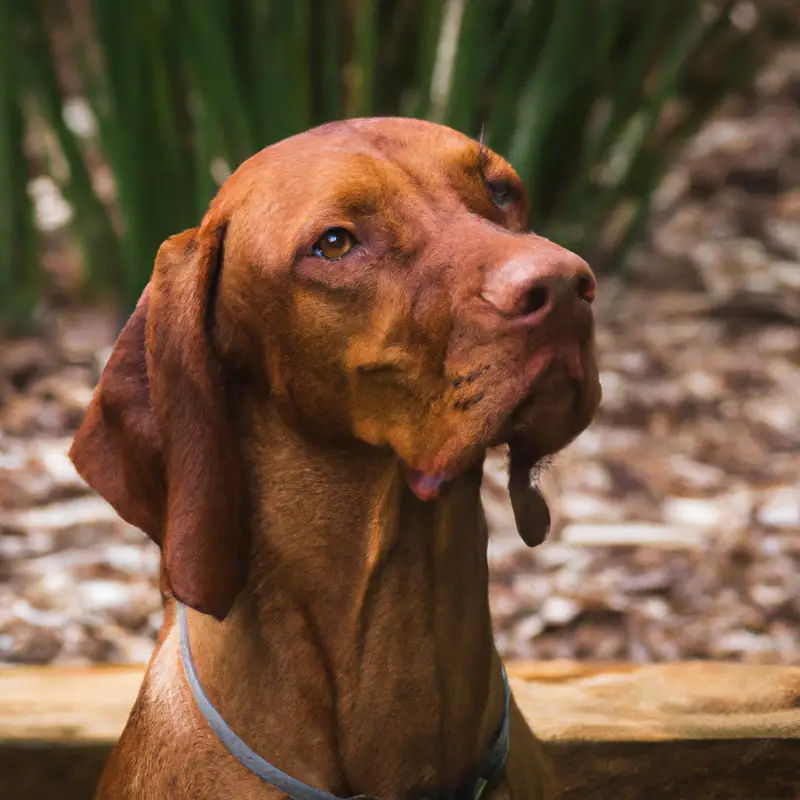
Symptoms of allergies in Vizslas
Allergies in Vizslas can lead to a variety of symptoms.
These may include intense itching, redness, and inflammation of the skin.
You may notice your Vizsla chewing or licking at their paws or scratching excessively.
Some dogs may develop hot spots, which are painful, irritated areas on the skin.
Ear infections and gastrointestinal issues can also be signs of allergies in Vizslas.
If you notice any of these symptoms, it’s essential to consult with your veterinarian for proper diagnosis and treatment.

Causes of allergies in Vizslas
Vizslas can develop allergies due to various factors such as environmental triggers, food sensitivities, or flea bites. These allergies can manifest as itchy skin, redness, hair loss, or ear infections.
It is important to work with a veterinarian to determine the specific cause of the allergy through allergy testing.
Once the cause is identified, management often involves avoiding the allergen, providing regular grooming and bathing, and sometimes using medications or dietary changes to alleviate symptoms.
Management and treatment of allergies in Vizslas
Managing and treating allergies in Vizslas requires a proactive approach.
Firstly, identify the allergen causing the reaction, whether it be food, fleas, or environmental factors.
Secondly, work with your veterinarian to develop a comprehensive treatment plan.
This may include dietary changes, medication, or environmental modifications.
Thirdly, regular grooming and bathing can help alleviate symptoms.
Remember, consistency and communication with your vet are key in managing your Vizsla’s allergies.
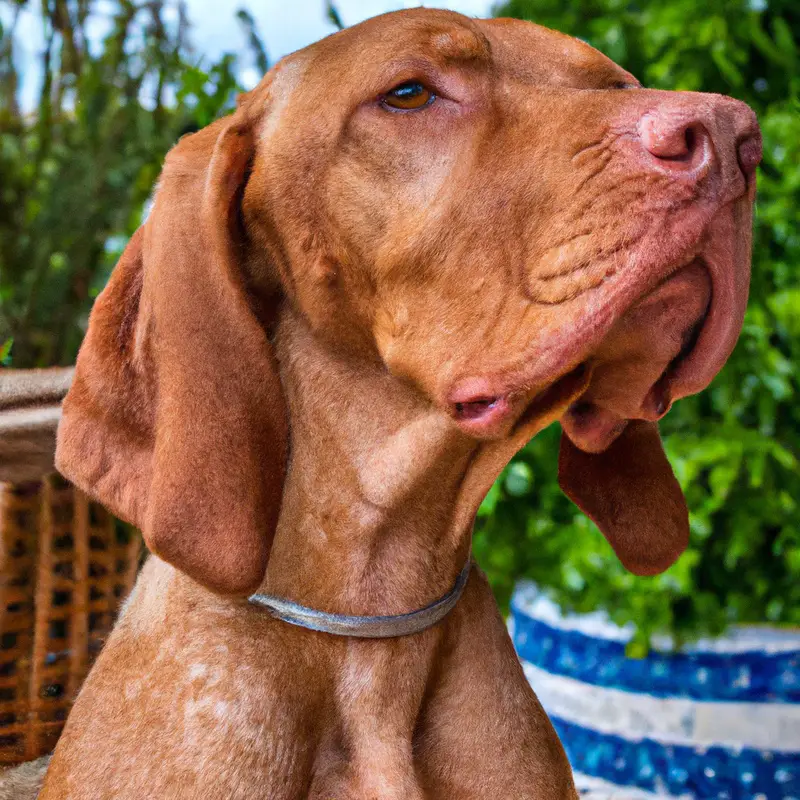
Hot spots in Vizslas
Hot spots, also known as acute moist dermatitis, are a common skin condition in Vizslas.
These are areas of irritated, inflamed skin that are often red, moist, and painful.
Hot spots can occur due to allergies, moisture, or other underlying skin issues.
To manage hot spots in Vizslas, it is important to keep the affected area clean and dry, limit your dog’s scratching or licking, and consult with a veterinarian for proper treatment, which may include antibiotics, topical creams, or changes in diet to address any underlying allergies.
Understanding hot spots in Vizslas
Hot spots, also known as acute moist dermatitis, are common skin irritations in Vizslas.
They appear as red and inflamed areas that may be itchy or painful for your dog.
These spots are often caused by allergies, insect bites, or excessive licking and scratching.
To manage hot spots, it’s important to identify and address the underlying cause.
Keeping your Vizsla’s skin clean and dry, using topical treatments prescribed by your veterinarian, and preventing your dog from licking or scratching the affected area can help alleviate symptoms and promote healing.
Regular grooming and a healthy diet can also contribute to preventing these troublesome hot spots.
Triggers for hot spots in Vizslas
Hot spots in Vizslas can be triggered by various factors.
These include allergies to food or environmental elements, fleas or other parasites, moisture trapped in their coat, and poor grooming habits.
Additionally, stress or anxiety can also contribute to the development of hot spots.
It is important to identify and address these triggers in order to effectively manage and prevent the occurrence of hot spots in Vizslas.
Regular grooming, a balanced diet, and flea prevention measures can greatly help in minimizing these triggers and keeping your Vizsla’s skin healthy.
Tips for managing and preventing hot spots in Vizslas
Hot spots in Vizslas can be managed and prevented with these tips:
- Regular grooming: Keep your Vizsla’s coat clean and well-maintained to prevent irritation and infection.
- Proper nutrition: Ensure your Vizsla is getting a balanced diet to boost their immune system and promote healthy skin.
- Avoid allergens: Be aware of any triggers that may cause allergic reactions in your Vizsla and try to minimize their exposure.
- Regular exercise: Provide plenty of exercise for your Vizsla to reduce stress and keep their skin healthy.
- Keep them cool: Avoid overheating your Vizsla, as excessive sweating can contribute to the development of hot spots.
- Prompt treatment: If you notice any signs of a hot spot, such as redness, swelling, or hair loss, seek veterinary care immediately.
Dry skin in Vizslas
Dry skin in Vizslas is a common issue that can cause discomfort for your furry friend.
To manage it, you can start by ensuring they have a balanced diet with essential fatty acids.
Regular grooming, including brushing and bathing, can also help.
Avoid using harsh shampoos or over-bathing, as it can further dry out their skin.
Additionally, make sure your Vizsla is well-hydrated by providing plenty of fresh water.
If the dry skin persists or worsens, it’s best to consult with your veterinarian for further advice.
Signs of dry skin in Vizslas
Dry skin in Vizslas can be identified through various signs.
These include:
- Flaky or scaly skin: If you notice your Vizsla’s skin appearing dry and flaky, it could be a sign of dry skin.
- Itching and scratching: Dry skin often leads to itching and scratching. If your Vizsla seems agitated and constantly scratches, dry skin may be the culprit.
- Redness and irritation: Dry skin can cause redness and irritation, particularly in areas that are frequently scratched or rubbed.
- Dull coat: Dry skin can affect the health and appearance of your Vizsla’s coat, making it look dull and lackluster.
- Hair loss: In severe cases, dry skin can cause hair loss or thinning patches on your Vizsla’s coat.
If you notice any of these signs, it’s important to address the issue and provide relief for your Vizsla.
Regular grooming, a balanced diet, and using moisturizing products formulated for dogs can help manage and prevent dry skin.
Common causes of dry skin in Vizslas
Dry skin in Vizslas can be caused by a variety of factors.
Some common causes include allergies, weather conditions, poor nutrition, and grooming practices.
Allergies can result from food or environmental allergens and can contribute to dry skin.
Extreme temperatures and low humidity levels can also dry out your Vizsla’s skin.
Additionally, a diet lacking in essential fatty acids can lead to dryness.
Finally, improper grooming, such as over-bathing or using harsh shampoos, can strip the natural oils from your dog’s skin.
Effective ways to manage and prevent dry skin in Vizslas
To manage and prevent dry skin in Vizslas, there are a few effective strategies you can try:
- Regular grooming: Brush your Vizsla’s coat regularly to remove any loose fur and distribute natural oils evenly. This helps to keep the skin moisturized.
- Use a gentle shampoo: Opt for a mild, moisturizing shampoo specifically designed for dogs to prevent drying out their skin. Avoid frequent bathing, as it can strip away natural oils.
- Moisturize: Apply a veterinarian-approved moisturizer or coconut oil to your Vizsla’s skin to keep it hydrated. Be careful not to use products with fragrances or harsh chemicals that could irritate their sensitive skin.
- Proper nutrition: Ensure your Vizsla is getting a balanced diet, rich in essential fatty acids. Omega-3 and omega-6 fatty acids found in fish oil or flaxseed oil can help maintain healthy skin.
- Hydration: Make sure your Vizsla has access to fresh water at all times to keep them properly hydrated. This helps to support overall skin health.
Remember, if your Vizsla’s dry skin persists or worsens, it’s always best to consult with your veterinarian for further guidance and treatment options.
Dermatitis in Vizslas
Dermatitis is a common skin condition in Vizslas.
It can cause itching, redness, and inflammation.
Some possible causes include allergies, fleas, or bacterial/fungal infections.
Treatment usually involves identifying and avoiding triggers, maintaining proper hygiene, and using medicated shampoos or ointments.
If your Vizsla is showing signs of dermatitis, it’s best to consult with a veterinarian who can provide proper diagnosis and recommend an appropriate course of treatment.
Regular check-ups and preventive care can help manage and prevent dermatitis in Vizslas.
Different types of dermatitis in Vizslas
Dermatitis is a common skin condition in Vizslas that can cause discomfort and irritation. There are various types of dermatitis that can affect these dogs.
These include atopic dermatitis, contact dermatitis, and flea allergy dermatitis.
Atopic dermatitis is typically caused by allergies to substances like pollen or dust mites. Contact dermatitis occurs when the skin comes into contact with an irritant or allergen.
Flea allergy dermatitis is a reaction to flea saliva.
Managing dermatitis in Vizslas often involves identifying and avoiding triggers, providing proper flea control, and using appropriate medications or treatments as recommended by a veterinarian.
Symptoms and causes of dermatitis in Vizslas
Dermatitis in Vizslas can cause discomfort and irritation for your furry friend. Common symptoms include itching, redness, and inflammation of the skin.
This can be caused by various factors such as allergies to certain foods, environmental allergens, or even parasites like fleas.
It’s important to identify the underlying cause to effectively manage dermatitis. Regular grooming, using hypoallergenic products, and maintaining a healthy diet are all essential steps in managing and preventing dermatitis in Vizslas.
Regular check-ups with your vet can also help in diagnosing and treating this condition.
Treating and preventing dermatitis in Vizslas
Treating and preventing dermatitis in Vizslas requires a combination of proper grooming, nutrition, and environmental management. Regularly bathing your Vizsla with a gentle shampoo can help remove allergens and keep their skin clean.
Ensure their diet includes quality ingredients that support healthy skin and immune function.
Minimize exposure to potential irritants such as certain cleaning products and allergenic plants. Regularly checking their skin for any signs of irritation or inflammation can help catch dermatitis early.
When in doubt, consult with your veterinarian for the best course of action.
Proper care and management of Vizsla skin conditions
Regular grooming routines for Vizslas
Regular grooming routines for Vizslas are important to maintain their healthy skin and coat. Brushing their short-hair regularly helps to remove loose hairs and prevent matting.
Additionally, regular bathing with a mild dog shampoo keeps their skin clean and reduces odors.
It is also essential to regularly check their ears for any signs of infection and trim their nails to prevent overgrowth. Remember to use appropriate grooming tools and techniques, and consult a professional groomer for any specific needs or concerns.
Happy grooming!
Choosing the right diet for healthy skin in Vizslas
To maintain healthy skin in Vizslas, it’s important to choose the right diet.
Here’s what you can do:
- Include high-quality proteins in their meals, such as lean meats like chicken or turkey.
- Omega-3 fatty acids are essential for healthy skin. Give them fish oil supplements or foods rich in omega-3, like salmon.
- Make sure their diet contains a variety of fruits and vegetables for essential vitamins and minerals.
- Avoid artificial additives, preservatives, and fillers in their food.
- Ensure they stay hydrated by providing fresh water at all times.
Remember, a nutritious diet is key to promoting healthy skin in your Vizsla!
Importance of proper hygiene and cleanliness for Vizslas
Proper hygiene and cleanliness are essential for the health and well-being of Vizslas.
Regular bathing helps to keep their skin and coat clean, reducing the risk of infections and skin irritations.
It is important to use gentle, dog-specific shampoos and to thoroughly rinse off all the soap.
Regular brushing helps to remove loose fur and prevent matting.
Additionally, keeping their living area clean and free from pests is also important.
Regularly cleaning their bedding and vacuuming the area can help prevent fleas and ticks.
Visiting a veterinarian for diagnosis and treatment options
If your Vizsla is experiencing skin issues, it’s important to seek professional help from a veterinarian. Visiting a veterinarian allows for proper diagnosis and treatment options specifically tailored to your dog’s condition.
During the appointment, the vet will thoroughly examine your Vizsla’s skin and may perform additional tests if needed.
Based on the findings, they will provide the appropriate treatment plan, which may include medications, ointments, or changes in diet. Regular follow-up appointments may be required to monitor the progress and make any necessary adjustments.
Remember to consult a veterinarian for accurate guidance and care.
Frequently Asked Questions about Vizsla skin conditions
Can Vizsla skin conditions be hereditary?
Yes, Vizsla skin conditions can be hereditary. Just like humans, dogs can inherit certain health issues from their parents.
Skin conditions in Vizslas, such as allergies or dermatitis, can be genetic, meaning they can be passed down from previous generations.
It’s important for Vizsla owners to be aware of this and work closely with their veterinarian to manage and treat any skin conditions that may arise. Regular check-ups and a healthy diet can also help prevent or minimize the impact of hereditary skin conditions in Vizslas.
Are there any specific products recommended for Vizsla skin care?
There are a few specific products that can be recommended for Vizsla skin care. A gentle, hypoallergenic shampoo formulated for sensitive skin is a good choice for regular bathing.
Additionally, using a moisturizing conditioner can help keep their skin hydrated.
It’s also important to protect their skin from the sun, so using a dog-specific sunscreen is recommended. Finally, certain supplements like fish oils can support a healthy skin and coat.
Consulting with a veterinarian can help determine the best products for your Vizsla’s specific needs.
Can Vizsla skin conditions be prevented?
Vizsla skin conditions can be prevented to a certain extent through good grooming practices and proper care. Regularly brushing your Vizsla’s coat removes dirt, debris, and loose hair, reducing the risk of skin irritation.
Moisturizing the skin with specially formulated dog-safe products can also help maintain its health and prevent dryness.
Additionally, protecting your Vizsla from excessive sun exposure and ensuring they have a balanced diet can contribute to overall skin health.
How long does it take for Vizsla skin conditions to heal?
The healing time for Vizsla skin conditions can vary depending on the specific condition and its severity. Mild skin issues like dryness or allergies may improve within a few weeks with proper care.
However, more serious conditions like infections or dermatitis may require several weeks or even months to heal completely.
It’s crucial to follow your vet’s advice and administer any prescribed treatments consistently to support the healing process. Regular check-ups and adjustments to the treatment plan may be necessary.
When should I seek professional help for my Vizsla’s skin condition?
If you notice that your Vizsla has a skin condition that is causing them discomfort or affecting their overall well-being, it is important to seek professional help.
Some signs that indicate it’s time to consult a veterinarian include persistent itching, redness or inflammation, hair loss, sores or lesions on the skin, and a foul odor.
Ignoring these issues or trying to self-diagnose could potentially worsen the condition or delay proper treatment.
Remember, your veterinarian is the best person to evaluate your Vizsla’s skin condition and recommend appropriate treatment options.
Final Verdict
As an expert in Vizsla skin conditions, I have discussed the common issues such as allergies, hot spots, dry skin, and dermatitis that Vizslas may experience.
I have provided valuable insights on the symptoms, causes, and management options for each condition.
Regular grooming, a proper diet, and good hygiene practices play a crucial role in maintaining healthy skin for Vizslas.
Seeking professional help from a veterinarian is also recommended for an accurate diagnosis and effective treatment.
By taking these proactive measures, you can ensure your Vizsla’s skin remains healthy and free from discomfort.

